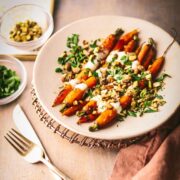Maple roasted butternut squash is one of the best side dishes as we head into the colder months of the year. It's nutty, sweet, and perfectly seasoned with maple syrup and a hint of chipotle powder.

It's also super quick and easy (once you get the squash dealt with, that is. I hate that job). It goes perfectly with pretty much any meat: chicken, turkey, pork, or beef, making it great for holiday season entertaining.
Whip up a tasty maple roasted butternut squash dish—a perfect blend of sweet and savory flavors. Ideal for 8 servings.
Jump to:
Frequently Asked Questions
To make peeling easier, microwave the squash for a minute or two to soften the skin before using a vegetable peeler.
Yes, the skin is edible when cooked. However, it's often removed because it can be tough.
Absolutely! It's rich in vitamins A and C, potassium, and fiber, making it a healthy choice.
It's not typically eaten raw due to its tough texture, but you can shred or spiralize it for salads.

What is Butternut Squash?
Butternut squash, a member of the gourd family, is a versatile and beloved ingredient in the culinary world. With its distinct elongated shape and pale orange hue, it offers a delightful blend of nutty and slightly sweet flavors. This winter squash variety is a favorite among chefs and home cooks alike for its culinary adaptability. Its tender flesh becomes creamy when cooked, making it ideal for both savory and sweet dishes.
Packed with essential nutrients, butternut squash boasts an impressive nutritional profile. It's a fantastic source of vitamins A and C, vital for supporting immune health and skin rejuvenation. Additionally, its fiber content aids in digestion and helps maintain a healthy gut. Whether roasted to caramelized perfection, transformed into velvety soups, or integrated into pasta and casseroles, butternut squash is a go-to ingredient for elevating the taste, color, and nutritional value of meals. So, if you're on the lookout for a versatile and wholesome addition to your recipes, look no further than the vibrant and flavorful butternut squash.
Ingredients
Butternut squash: Its tender flesh becomes wonderfully caramelized when roasted, providing a sweet and hearty base for the dish.
Maple syrup: The natural sweetness complements the squash's flavors, enhancing its taste and contributing a lovely glaze.
Olive oil: Offers a rich, smooth texture while helping the squash achieve a desirable crispness on the outside.
Salt and pepper: These essential seasonings balance the sweetness, highlighting the squash's inherent earthiness.
Optional chipotle powder: Adds a hint of smokiness and gentle heat, creating an intriguing contrast to the sweetness.
Optional sage leaves: Infuses a delicate herbal aroma and visual appeal, enhancing the overall dining experience.

How to Make Roasted Butternut Squash
Step 1: Preheat the Oven
- Start by preheating your oven to 400°F (200°C). This ensures it's nice and hot for roasting.
Step 2: Prepare the Butternut Squash
- Take a large butternut squash and peel it. Then, cut it in half, scoop out the seeds, and chop the flesh into bite-sized cubes. Aim for uniform sizes to ensure even cooking.
Step 3: Toss with Maple Syrup and Olive Oil
- In a bowl, combine the cubed butternut squash with ¼ cup of maple syrup and 2 tablespoons of olive oil. This mixture will coat the squash and give it a fantastic flavor and texture.



Step 4: Season to Taste
- Sprinkle in a pinch of salt and pepper. These basic seasonings will enhance the natural flavors of the squash. If you like a hint of smokiness and a touch of heat, you can also add ½ teaspoon of chipotle powder at this stage.
Step 5: Mix It Up
- Gently toss all the ingredients in the bowl, ensuring the butternut squash cubes are evenly coated with the maple syrup, olive oil, and seasonings.
Step 6: Spread on a Baking Sheet
- Take a baking sheet and line it with parchment paper for easy cleanup. Spread the coated squash cubes in a single layer. This helps them roast evenly and develop that wonderful caramelization.

Step 7: Roast to Perfection
- Place the baking sheet in the preheated oven and let the magic happen! Roast the butternut squash for around 25 to 30 minutes, or until the cubes are tender and slightly caramelized. Give them a gentle stir halfway through for even roasting.

Step 8: Optional Sage Leaves Garnish
- If you're feeling fancy, you can scatter fresh sage leaves on top of the roasted squash before serving. These aromatic leaves add a lovely visual touch and an extra layer of flavor.
Step 9: Serve and Enjoy
- Once roasted to perfection, take the baking sheet out of the oven and let the squash cool slightly. Then, transfer it to a serving dish, optionally garnishing with the sage leaves.
Variations
Roasted butternut squash is such a versatile ingredient, there really is no end of ways to use it. Here's a few different ideas for you if the maple just isn't cuttin git.
- Garlic-Rosemary Infusion:
- Add minced garlic to the maple syrup and olive oil mixture for a savory punch.
- Toss in fresh rosemary leaves for a fragrant and earthy aroma that pairs beautifully with the sweet squash.
- Herb-Infused Greek Yogurt Drizzle:
- Create a tangy and creamy contrast by mixing Greek yogurt with chopped fresh parsley and a hint of lemon juice.
- Drizzle this yogurt sauce over the roasted butternut squash just before serving for a delightful burst of flavors.
- Goat Cheese and Honey Elegance:
- Crumble creamy goat cheese over the roasted squash while it's still warm.
- Drizzle a touch of honey over the dish for a harmonious blend of sweet and tangy notes.
- Mediterranean Delight with Feta:
- Crumbled feta cheese brings a salty and tangy kick to the dish.
- Combine diced Kalamata olives, chopped fresh parsley, and a sprinkle of za'atar spice for a Mediterranean twist.
- Cinnamon and Nutmeg Warmth:
- Instead of chipotle powder, dust the squash cubes with a mix of ground cinnamon and nutmeg for a cozy and comforting flavor profile.
- This variation highlights the natural sweetness of the squash in a warm and aromatic way.
- Toasted Pecan Crunch:
- Toss in some chopped toasted pecans before roasting for a delightful crunch and nutty flavor.
- The nuts add texture and depth to the dish, making it even more satisfying.

Storage and Reheating
Storing:
Allow the roasted butternut squash to cool to room temperature.
Transfer any leftovers to an airtight container. If you used sage leaves as garnish, remove them before storing, as they can become soggy.
Place the container in the refrigerator. The roasted squash can be stored for up to 3 days.
Reheating:
Preheat your oven to 350°F (175°C).
Spread the leftover roasted squash on a baking sheet in a single layer. This helps to ensure even reheating.
Roast the squash in the preheated oven for about 10-15 minutes, or until it's heated through.
Alternatively, you can reheat smaller portions in the microwave. Place the squash in a microwave-safe dish, cover with a microwave-safe lid or microwave-safe plastic wrap, and heat in 30-second intervals until warmed.
Remember that reheating might slightly alter the texture, as the squash could become a bit softer. However, the flavors should still be delicious!
Other Awesome Side Dishes
📖 Recipe

Maple Roasted Butternut Squash
Ingredients
- 1 large butternut squash seeded and cubed
- ¼ C maple syrup
- 2 tablespoon olive oil
- ½ teaspoon salt
- ¼ teaspoon pepper
- ¼ teaspoon chipotle powder optional
Instructions
- Preheat your oven to 400°F (200°C).
- In a large bowl, combine cubed butternut squash, maple syrup, olive oil, salt, and pepper. Toss well to coat evenly.
- If using chipotle powder, sprinkle it over the squash and gently toss again to distribute the flavor.
- Spread the coated squash evenly on a baking sheet in a single layer.
- Roast in the preheated oven for about 25-30 minutes or until the squash is tender and slightly caramelized, stirring halfway through.
- Once cooked, remove from the oven and let it cool slightly.
- If desired, garnish with fresh sage leaves before serving.
Video
Notes
- For a bolder flavor, adjust the chipotle powder to your preferred level of heat.
- Ensure uniform cubing of the squash for even roasting and consistent texture.
- Experiment with drizzling a touch of balsamic glaze before serving for a tangy twist.
- Don't hesitate to toss in your favorite herbs like thyme or rosemary for added depth.
- Leftovers can be stored in an airtight container in the fridge for up to 3 days.
- Reheat leftovers in the oven or microwave, but note that the texture may soften slightly.
Nutrition
Hi, I'm Cara! I'm a food writer, journalist, and recipe developer. I'm obsessed good food, good wine, good cocktails and entertaining. I've picked up a few tips over the years, and love sharing them with others.











Leave a Reply